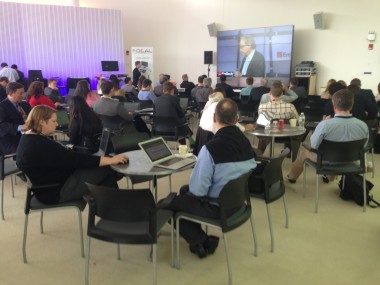There was much to take away from MIT’s EmTech conference on future technology. Highlights included learning about the way drones are being used to make our crops grow better and about how Chinese search giant Baidu is delving into artificial intelligence by using deep learning.
However, the overarching theme of the event was the young entrepreneur. Whether it’s the company helping map peoples’ genomes or a firm that builds learning robots, the young entrepreneur is playing a massive role in shaping the future of tech.
Here are three of the most helpful tips speakers at EmTech had for all those young entrepreneurs creating companies which may well change the world.
Focus on the Product Path
 A drone demonstration at EmTech
A drone demonstration at EmTechBefore you change the world, you must first understand it. During the conference, Michael Harries, Chief Technologist at the Citrix Startup Accelerator, said entrepreneurs need to push themselves to find what really matters and focus on it. “You must make a difference. Usually you need to work out the path yourself (to see the way a technology will change). Look through all the possible iterations and find low hanging fruit.”
“Focus. That is certainly something that we’ve learned and something we’re still learning,” said Andrew D’Souza, President of Bionym, a FitBit-like wearable that not only tracks your heartbeat, but allows you to use its rhythm as a passcode to unlock your car, home, or computer. “You must really try to to the maximum extent possible find a specific kind of bleeding problem that people can’t find a good solution for anywhere else. Because when you start a new company, especially if it is an exciting new technology, you’re going to get a lot of interest from different people who think it’s cool and they want to work with you to build the product. But if you haven’t articulated, ‘Here’s exactly who my customer is, this is exactly the problem we can solve for them,’ then you can get pulled in a number of different directions and then sometimes projects get killed…then you’re at risk.”
Care for Your Customer, Don’t Concentrate on Sales
As a startup founder, it is important to identify those early adopters who will pull your invention into reality. That means going out into the field and talking to potential customers to see whether your service or product is something they actually want. This falls under investor Steve Blank’s “lean startup” concept that founders must “leave the building” and “test their hypotheses” about the validity of their ideas.
“We guard against too much sales early on,” said Harries. “It’s more about finding out what people think. For these earlier startups, you have to ask, ‘Does the vision correspond to reality?’ It’s really important for folks to go through that. Turn over the stones and find the right people – query the market. It’s about customer empathy rather than sales. The more customers that are in place, the more investors will come to the party.”
Find Team Members Who Believe in Your Vision
 The EmTech Lounge
The EmTech LoungePeople matter. Whether it’s your co-founders or your employees, who you work with will make or break your business. Be ruthless in searching for the right people. Find people you are happy to be around and communicate with well. It may seem difficult to find a perfect match, but the right people are out there.
“It’s really important, early in the conversation, whenever you’re looking at hiring somebody or joining forces with somebody, to understand their motivations,” said D’Souza. “If it feels like too much of a sales pitch, their motivation is probably not in the right place and they probably don’t share your vision. I’m not a founder, but I joined the team, and when I met the founders and I heard their vision, I stayed up the next three nights thinking about it. I wrote our marketing plan one night and I wrote our investor pitch the next night. So it was kind of one of these things where I couldn’t stop thinking about the problem that we were solving and how we were going to do it. Most of our team has had that exact same experience. Once they kind of wrapped their head around ‘hey here’s the problem that we’re able to solve,’ they come back to us hours later or days later with new ideas throughout the interview process and those are the type of people you’re looking for.”
The journey of the entrepreneur is a long and difficult one, filled with highs and lows that tax even the hardiest of innovators. There are literally hundreds of areas where advice can be helpful, but if you pay attention, a few larger themes emerge. First, work at creating a product that truly fits customer demand. Go into the real world and make sure there’s a need for what you’re creating. You must also ensure the people you hire are as enthusiastic about the company vision as you. Addressing these overarching issues will help you feel more secure about your venture, and put you on the road to success.
Photos by: John Boitnott, Courtesy of MIT’s EmTech 2014
Relationship disclosure: MIT gave SEJ a conference pass, but there was no requirement to cover the event.




